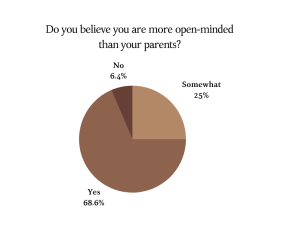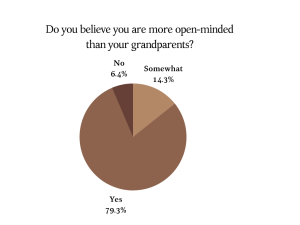Discrimination
April 6, 2023
In a world constantly swept up in the current of change, the society in which current East students have grown up in is drastically different from that of their parents and grandparents. Subsequently, Gen Z, a population actively pursuing change to break past rigid sociocultural norms, is found face to face with older generations that learned to accept those very same norms.

Throughout recent years, there has been marked change and advocacy for the rights of LGBTQ+ people and a breaking of the conventional binary for sexual orientation that was forcibly perpetuated for generations. Because of these changes, many people from preceding generations view the recent process towards inclusivity as an attack against their customary beliefs.
“[Older generations] feel as though this generation (Gen Z) is trying too hard to be different, and are making too many “edits” to society that are more complicated than need be,” wrote one student.
In terms of gender equality, on the surface, it may seem that our society has come a long way: recent generations have redefined gender norms and relationships. However, old habits die hard and if the overturning of Roe v. Wade provides any indication, traditional gender norms and still hold a strong presence in today’s politics and society.
The idea of marriage is one prominent point of disagreement among older and younger generations. While today’s youth have developed diverse ideas about family structure, many older individuals still cling to the traditional ideals: a mother, a father, and children.
“I had a discussion with an adult and they [insisted] that I would change my mind about not pursuing a marriage and not wanting biological children,” wrote one student.
This black and white view also discounts people who do not neatly fit into the traditional two-box view of gender. Sexist ideologies continue to additionally pervade in the binarization of “masculine” and “feminine” activities, a dichotomy still reinforced from past generations.
“I am an athlete and I’d say I workout somewhat often, which is a concept my grandmother, who is 93, finds completely obscure because she views fitness and sports as masculine activities,” wrote a student.
Many members of Gen Z have worked to push to evoke change in breaking traditional impeding beliefs. Part of the reason younger generations may be more tolerant and accepting towards different identities is because the very society we’ve grown up in is more diverse. In the U.S., the diversity in generations is only increasing. According to the Pew Research Center, Millennials are the most racially and ethnically diverse adult generation in history — and Generation Z, the next generation, is even more so. Today’s world is a combination of different cultures and backgrounds, constantly exchanging ideas and interacting with one another. However, this wasn’t always the case.
“My grandmother talked about growing up in Trenton where every different religious/cultural sect (she is Polish) lived in different areas and only met occasionally,” wrote one student. “Now, people are so much more integrated with their community and aren’t split into different sectors like that.”
Gen Z’s fight for inclusivity also echoes a larger perception of open-mindedness among the population. In a survey of 140 East students, 68.6% of students responded that they believed that they were more open-minded than their parents and 79.3% said that they were more open-minded than their grandparents.

“Any homophobic or racial comments that someone older than me (at home and in the classroom) has made [are] based on nothing but simply ignorance and the need to fit into the “society” that they were brought up in. It’s almost impossible to explain to those individuals why their remarks are not okay or acceptable, and how they have such an unawareness for their surroundings and how their comments can affect younger individuals,” one student wrote.
This is largely explained due to how accustomed attitudes on principal topics — for instance, race — have transformed significantly over time. Brookings Education reports that between 1958 and now, if a Black family moved to be someone’s next-door neighbor, 44% to now 1% would move, and between 1964 and now, 18% to 86% of white people say they have a Black friend. While this demonstrates an incumbent shift towards more inclusive views, it also demonstrates a significant gap between racial ideologies throughout time. Yet, again, as views shifted and norms transfigured, some people were left in the past, transfixed in the values that society once accepted.
“My grandmother often makes jokes in reference to other races and skin colors and has negative perceptions of different races,” one student wrote.
This misunderstanding of how the tides of change have risen in support for marginalized and misunderstood groups, have left members of one generation pushing for greater waves and members of other generations holding up crumbling walls.